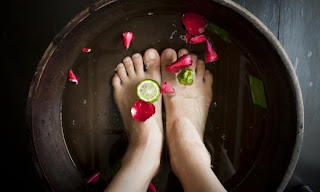In chapter 10, The F-M Circulizer System, Fischer discusses the use of an herbal footbath and how herbs in a footbath can improve your skin and help you eliminate acne.
This book was written in 1986 and Fischer claims herbal footbaths have been in use overseas since 1946!
Now, you can do either a footbath or a hand bath. Once you prepare a container with hot water you can put your feet or hands into it and get the same results.
When you use a heated footbath, veins in your feet start to expand. Over a period of 15-20 minute, the warm water affects your entire vascular (blood) system and you get improved blood circulation.
By adding an herbal infusion into the hot water in the footbath, minerals and other phytochemicals from the herbs enter the soles of your feet and into your blood stream.
This means that you can introduce herbal phytochemicals into your blood stream using the footbath. During your footbath, these herbal chemicals quickly circulated throughout your body and get to work neutralizing acid, killing bacteria, and improving your skin circulation.
Here is an herbal combination you can use. This herbal combination was taken and modified slightly from a book written by Daniel B. Mowrey, Ph.D., called The Scientific Validation of Herbal Medicine, 1986. Mowrey says,
"This (herbal) blend attacks external skin disorders from within, purifying the blood, carrying away waste, reinforcing the blood's ability to ward off infectious agents."
The herbal combination to use is,
* Dandelion root - purifies blood and improves liver function
* Yellow dock root - purifies blood, helps liver, is anti-bacterial
* Sarsparilla root - has antibiotic action, promotes waste elimination through urine and sweating
* Echinacea - increases immunity and promotes skin healing
* Licorice - protects the liver so that it can detoxify the blood better
* Kelp - provide minerals and vitamins and binds heavy metal that are bad for health
* Chaparral - is anti-microbial making effective against acne.
* Fresh Garlic - cut up a few cubes of garlic and place them into the hot water.. garlic has antibacterial properties
Buy one ounce of each herb and mix them together.
Here's how to do the herbal footbath..
* Place 2-3 tablespoons of herbal mix into 1 ½ cups of water.
* Boil the water with herbs - use only a glass, porcelain, or stainless steel container.
* After water starts to boil, pull the container off the stove.
* Let tea sit for 15-30 minutes. The longer the tea sits the stronger the tea and its effects.
* Prepare your foot spa with water.
* Strain the tea to remove leaves and roots.
* Pour tea and the cut garlic into the foot spa.
* Place your feet or hands in the hot water for 15 - 30 minutes.
The footbath is a convenient way to bypass your digestive system and get more nutrients into your body. Try it.. you'll like it!


